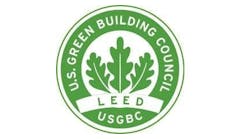Federal, state, and local government facilities have evolved under the demands for greater security and sustainable design. With government agencies becoming increasingly more complex and specialized, it’s only natural that the buildings that house them follow suit.
Higher Quality
“There’s been a general philosophy change. In the 1960s, the government built Class-B (or maybe even Class-C) buildings for government employees. The feeling now is that they ought to be in the same quality of buildings as the rest of the workforce,” says Tom Olmstead, vice president, government programs, at Minnetonka, MN-based Opus Group. With demands for hard-working, skilled, and experienced employees resulting in a tight labor market, the government examined how its real estate could increase worker productivity and improve employee recruitment.
The government wants to work smarter (not harder), spend less on building operations, and design for efficiency. Technology demands and energy costs have provided additional motivation to build and lease better spaces. Installation of underfloor air distribution and wire/cable, which decreases churn costs and increases employee comfort, is just one approach being used by some government buildings to address these concerns. “Government is making much more intelligent requests of the private sector to build buildings that meet their function, that are architecturally significant, but make intelligent cost decisions,” says Tom Walker, Opus Group’s senior director of government programs.
Whether owned or leased space, the priorities are the same. “The main difference from the past is that the government is now requiring the same standards in government-leased buildings as [it is] in government-constructed buildings that [it owns],” explains Walker.
Sustainability
Since the energy crisis of the 1970s, buildings nationwide have been trying to reduce use and costs. It wasn’t just offices, schools, and manufacturing facilities that were interested in energy efficiency; government buildings rallied to enforce conservation as well. More recently, the Washington, D.C.-based U.S. Green Building Council’s Leadership in Energy and Environmental Design (LEED) Green Building Rating System® and the Washington, D.C.-based U.S. Environmental Protection Agency’s ENERGY STAR® program have furthered efforts to build, modernize, and operate buildings using environmentally friendly guidelines. Many cities have even incorporated LEED certification into the requirements for construction of new municipal facilities.
Because the government is a long-term owner of these properties, lower operating costs make the decision to go green a natural choice. “Government, obviously, needs to be concerned about first cost; but, if you’re building a building for 100 years, you should be looking at the cost over the long term rather than just the first couple of years,” says Robert D. Loversidge, president and CEO, Schooley Caldwell Associates, Columbus, OH.
Lighting controls, VAV boxes, and green roofs are just a few of the high-performance, sustainable systems being installed in new and existing government buildings. Water conservation and stormwater management (e.g. capturing stormwater to use for irrigation) are becoming more common as well.
Safety and Security
Acts of terrorism (like 9/11 and the earlier Oklahoma City Bombing on April 19, 1995) have proven how important building security and life safety are. The lessons learned from these tragedies have impacted the design of new government facilities as well as changed the operation of existing ones. Facilities professionals and building team members have had to weigh the decision to increase security while still illustrating that government is “for the people.”
Access control and perimeter security have risen in importance. Existing buildings have had to make room for turnstiles and metal detectors while limiting the number of entry points. Government buildings being built today are considering everything from site selection to setback distance in order to maximize safety and security. “There’s an increased pressure, based on security, for new facilities to be built away from the center of the city; if you have stand-off distance, you can secure a facility more easily,” explains Loversidge.
Olmstead agrees: “A lot of government buildings in the past have been very close to the curb or streetside. Most government buildings now have either a 50-foot or 100-foot setback, depending on the type of facility and the perceived threat,” he says.
Additionally, government buildings (owned and leased) are utilizing shatterproof or blast-resistant glass. They are also being built to eliminate the likelihood of progressive collapse and using thicker precast concrete to meet strict overpressure requirements.
“The way government works today is different than it was 100 years ago or more when many of these buildings were built,” says Loversidge. Not only are government departments and agencies becoming increasingly specialized, they are becoming less centralized. Changes in our society and our environment have resulted in different demands from government facilities. “We’re adding energy conservation, practicing sustainable design, increasing the functionality of the buildings, and making them more secure for the people that work there and the people that visit. At the same time, we’re making government more accessible to the people.”
Jana J. Madsen ([email protected]) is managing editor at Buildings magazine.

